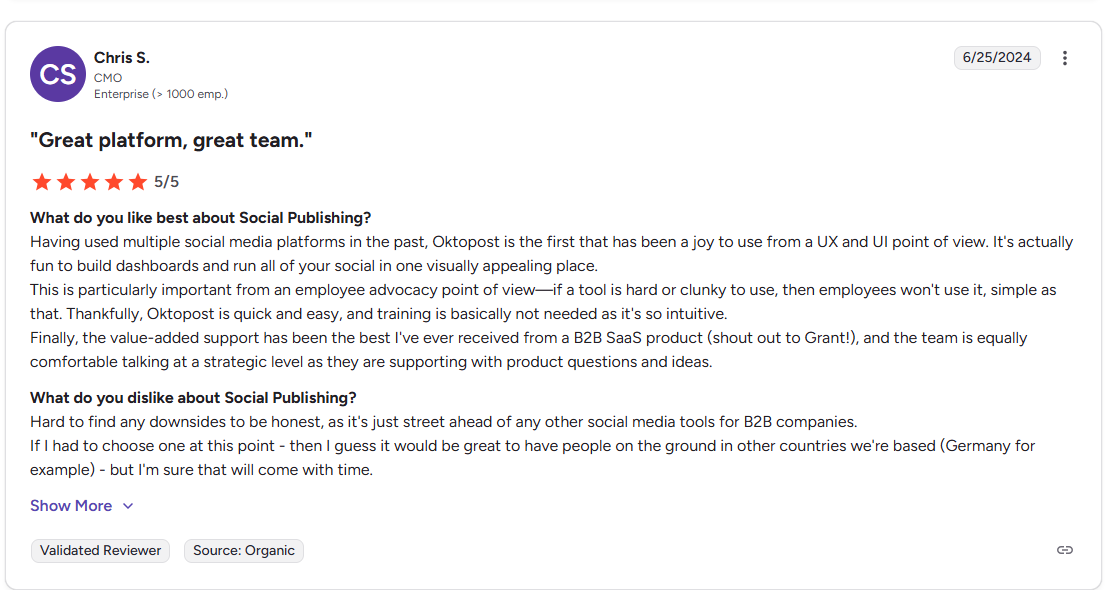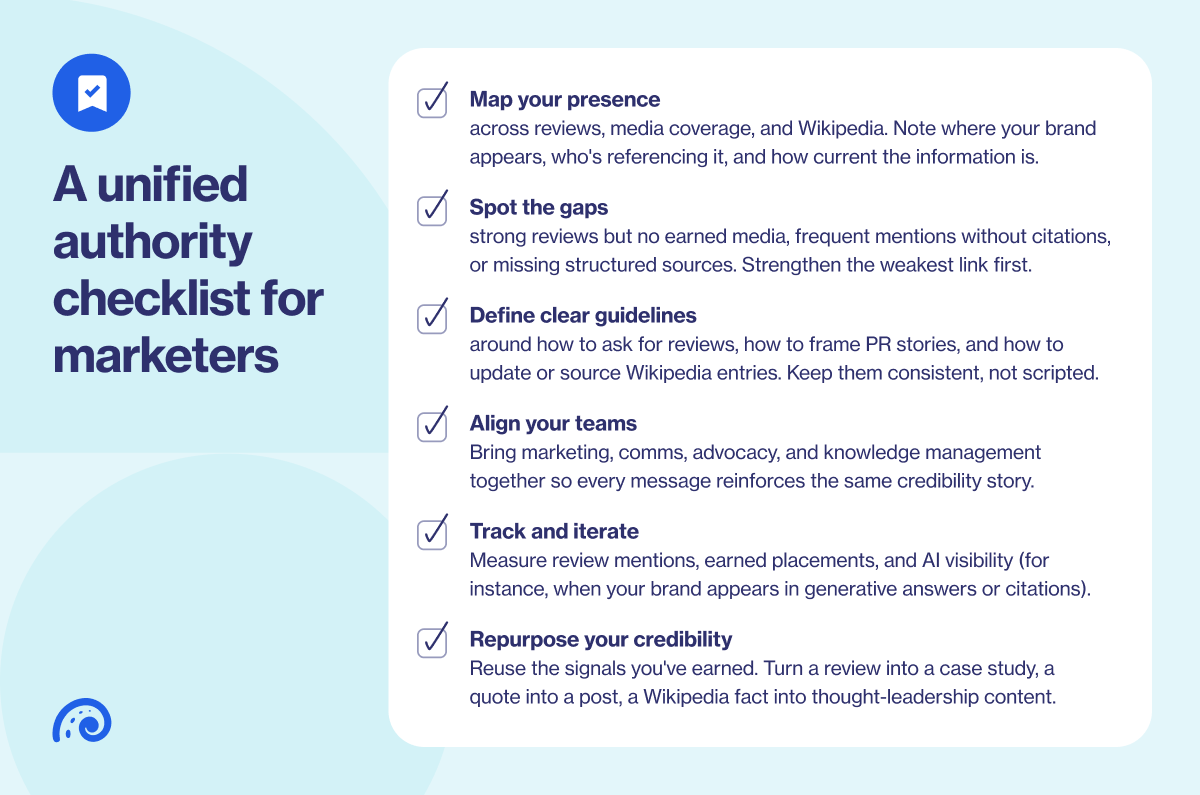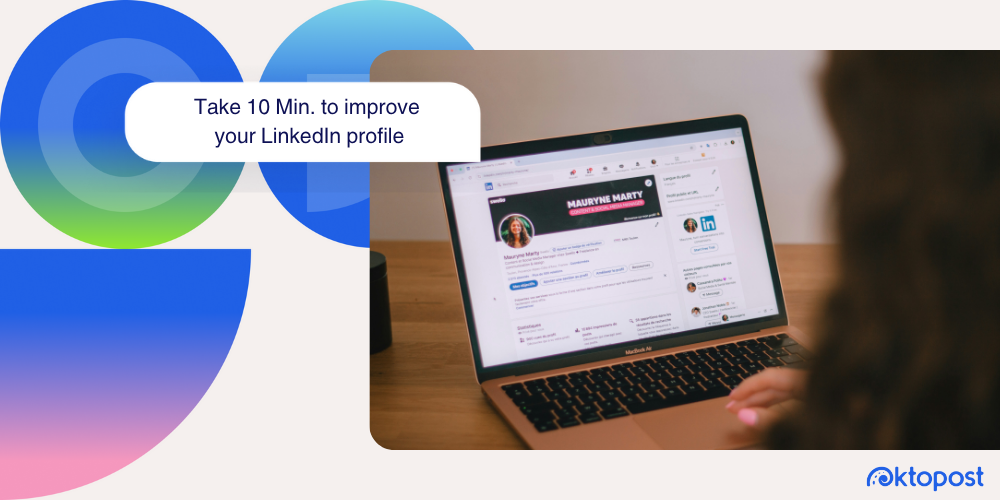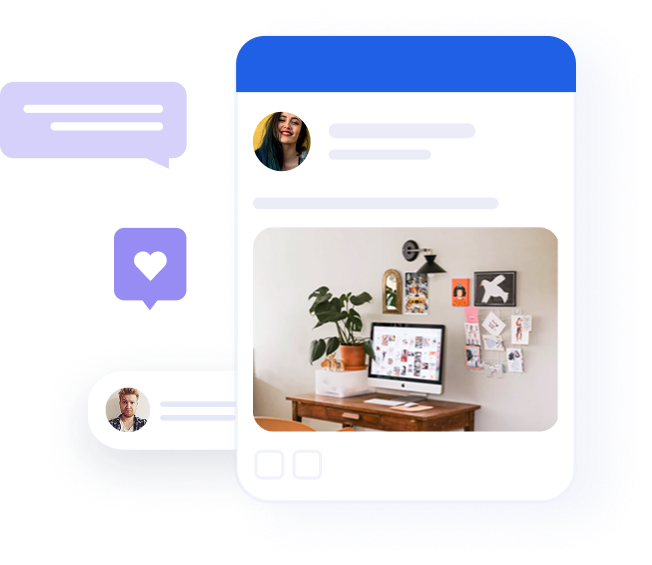How to build B2B brand authority that AI and search engines trust

Table of contents
There was a time when the number of links could measure online authority. More backlinks meant more power, and search engines rewarded whoever could build the biggest network.
That is still true to some extent, but the world is fading fast.
Today’s search engines and AI models generate answers drawn from sources they’ve already decided to trust. Authority has become a function of visibility within credible ecosystems, not volume within keyword maps.
In this environment, the brands that surface most often are the ones consistently referenced, cited, and reinforced across reliable networks.
Those networks tend to revolve around three powerful signals:
- Reviews that reflect authentic human experience.
- PR and earned media that validate expertise through independent coverage.
- Wikipedia and knowledge graphs that establish factual consistency over time.
Together, they form the pattern AI recognizes as authority, and the framework modern marketers can use to build it.
Why authority signals have changed in the AI era
Just as B2B prospects give more credence to employee advocacy than brand content, AI prioritizes reviews in its evaluation of businesses. Muck Rack found that over 95% of links cited by AI come from non-paid, independent sources. Earned and user-generated content (such as reviews) drive most of that.
Reviews are peer-to-peer, human-generated, and constantly refreshed. Each one contains linguistic variety, context, and emotion. Those features make them ideal training data for large language models.
Platforms like G2, Capterra, and even Reddit have evolved into ecosystems where real customers describe your product in their own words. For B2B companies, these are powerful buying signals for prospects and equally powerful semantic signals for AI models. When hundreds of users describe your platform as “intuitive,” “secure,” or “easy to integrate,” AI models learn to associate those terms with your brand.
Reddit is especially useful as a place where users can share their experiences or compare solutions in a forum that encourages engagement and dialogue. Forrester estimates that 72% of tech decision-makers use Reddit for precisely this type of peer review.

How reviews shape AI’s understanding of your brand
AI systems look beyond star ratings. They analyze mention frequency, sentiment, phrasing diversity, and cross-platform consistency. When your G2 page, LinkedIn recommendations, and TrustRadius reviews lean on the same themes, this reinforces your brand’s credibility inside AI knowledge graphs.
How to strengthen your review ecosystem:
- Encourage authentic participation. Motivate customers, employees, and partners to share honest experiences. Never script the language.
- Prioritize depth over volume. Rich, narrative-style reviews with specific outcomes (“saved 10 hours a week,” “cut manual reporting time”) teach AI what your product does and who it serves.
- Monitor themes across platforms. Track the recurring language users employ and integrate those phrases into social posts, blogs, and product pages, so the same signals echo across the web.

These reviews provide AI (and future buyers) with rich, trustworthy data to learn from.
Wikipedia’s role in B2B credibility
Community-managed sources like Wikipedia, Wikidata, and other structured knowledge graphs have become the internet’s trusted nodes. These are the places AI models turn to when they need to verify facts, establish relationships between entities, and build context for accurate answers.
This is happening because these platforms check all the boxes for algorithmic stability:
- Wikipedia pages are publicly editable yet transparently tracked.
- A citation backs every statement, and every edit is time-stamped.
- Every page includes metadata on dates, categories, and external references.
To an AI system parsing millions of data points, that combination of structure, transparency, and verification signals is “trustworthy.” According to Semrush, in the digital technology category, Wikipedia has a 167% citation frequency in ChatGPT outputs. In other words, if Wikipedia is talking about a tech brand, ChatGPT will follow suit.
Earning your place in the Wikipedia ecosystem
If your brand doesn’t yet meet Wikipedia’s inclusion criteria, this could be a viable goal for your next planning cycle as a B2B marketer.
- Establish notability through consistent coverage in credible industry or business media.
- Publish and share original insights: Research, data, or expert commentary that others cite independently.
- Elevate executive visibility with verified bios, speaking roles, and thought leadership placements.
- Strengthen your citation trail by ensuring your website and partners reference verifiable facts: dates, milestones, leadership, and links from trusted domains.
If your B2B brand does have a Wikipedia page, focus on turning it into a dependable reference point for AI:
- Audit your page to ensure details about your company, executives, and products are properly sourced and neutrally written.
- Check for completeness: Missing sections (leadership, history, or product details) can cause AI to fill in the blanks with outdated or third-party information.
- Cross-link responsibly: Where relevant, support Wikipedia’s facts with citations from your own site and other authoritative sources. Remember to be neutral and comply with community rules.
Recommended for further reading
Why PR and earned media matter more than ever
Public relations, once viewed as a brand-awareness play, is quietly becoming a key AI visibility strategy.
Just as Wikipedia mentions, or quotations in reputable publications signal to AI that they are verified facts. Editorial content comes with built-in credibility markers: author names, publication timestamps, backlinks, and journalistic oversight. Together, these form a trail of structured, verifiable data that large language models use to determine what’s true.
How earned media builds AI credibility
The first thing a human reader notices in a PR piece is the digital venue it’s in. They see Forbes or TechCrunch and immediately assume what they’re reading is important.
AI models don’t “see” things that way. What matters to them is the relationships a well-placed piece of PR creates.
Every time your company or an executive appears in a credible outlet, it strengthens the network connections between your brand, your topic cluster, and related keywords. Over time, these repeated, consistent associations increase your brand’s entity strength in the AI’s knowledge graph, the system of concepts that underpin generative answers.
Best practices for building authority that machines (and humans) recognize:
- Aim for thought leadership, not just visibility. Focus PR efforts on editorial placements, bylines, and expert commentary rather than relying solely on traditional press releases.
- Anchor your stories in data and insight. Executives and authors who share unique data points, original research, or real-world case examples are more likely to be cited and recited by AI.
- Make your earned coverage machine-readable. Ensure that articles, interviews, and reprints include clear author attribution, publication dates, and relevant tags or schema markup so AI systems can easily index and interpret them.
- Syndicate wisely. When coverage appears in multiple outlets, verify that each instance links back to your domain or executive profile to reinforce the source network.
Connecting the dots for a unified brand authority strategy
AI is pattern-hungry and rewards consistency. When reviews, earned media, and Wikipedia entries align, they form a reinforcing loop of credibility:
- Reviews feed authenticity through human voices and lived experience.
- PR and earned media build editorial authority through “verified mentions” that AI heavily weights.
- Wikipedia and other structured databases provide the factual scaffolding that ties everything together inside the knowledge graph.
Brands with consistent, high-quality signals across all three pillars are more likely to appear in AI-generated summaries, answer boxes, and citation lists.

Bringing it all together: building a trusted B2B brand
If you’ve read this far, you already understand the shift. The next step is to turn awareness into action:
- Bookmark this article and share it with your comms, PR, and social teams.
- Start mapping your 2026 authority strategy to unite earned media, authentic reviews, and factual accuracy into a single visibility plan.
- Audit your brand’s trust signals across people, publications, and platforms. Where do they align, and where do they contradict each other?
Machines are already influencing your reputation. You can’t change that fact, but you can influence how it happens.
Ensure that the signals AI learns from come from people who know your brand best: your employees, customers, and advocates.
Oktopost: the B2B solution for credible brand visibility
Oktopost helps B2B marketers turn those authentic human signals into measurable visibility across social, search, and AI-driven discovery.
Book a demo to see how your brand can build the authority machines (and markets) trust.




